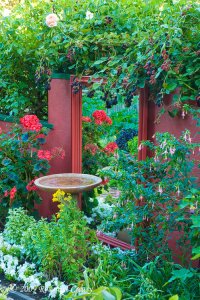

What is Edible Landscaping?
Edible landscaping is the practical integration of food plants within an ornamental or decorative setting. The same design principles as for ornamental landscapes are used, while substituting edible plants such as lettuces, blueberries, vegetables and fruit trees for some of the otherwise unproductive plant material. Using edibles in landscape design can enhance a garden by providing a unique ornamental component with additional health, aesthetic, and economic benefits. Edible landscaping is a mixture of beauty and utility. However, edible landscaping doesn’t have to be all edible. In fact, filling the yard with edibles would often produce too much food for most families, not to mention time and work. Instead, careful planning and the judicious use of fruits, herbs, and vegetables results in a yard that is flavorful, practical, visually pleasing. As a bonus, it’s a great topic for conversation!
Homeowners in all climates-with small or large yards-can benefit from a trellis of cherry tomatoes cascading over the entryway, a fragrant border of colorful and flavorful basils, or a prolific semi-dwarf apple tree or two. There are tasty and ornamental edible plants for just about any garden setting in any climate. Only the most shady areas and soggy soils are not suitable. The sunniest spots and the areas with the choicest soil are best reserved for most fruit trees and annual vegetables. On the other hand, there are culinary herbs suitable for rocky or poor soils, and a few perennial edibles for wet locations. Theoretically, any edible plant can be used in an ornamental landscape; but practically and aesthetically, some are better suited than others.
Combining Edibles and Ornamentals
 Edible plants can be combined in many creative ways-with other edibles, or with ornamentals. For instance: try a cool-season border of lettuces and spinach interplanted with dwarf nasturtiums. All types of pepper are striking when combined with dwarf marigolds or a background of tall red salvias. In shady areas, try a border of alpine strawberries and curly parsley under a hedge of currants. For your dwarf fruit trees try planting them in geometric beds surrounded with a border of culinary herbs; or plant them along the driveway instead of the usual privet or junipers.
Edible plants can be combined in many creative ways-with other edibles, or with ornamentals. For instance: try a cool-season border of lettuces and spinach interplanted with dwarf nasturtiums. All types of pepper are striking when combined with dwarf marigolds or a background of tall red salvias. In shady areas, try a border of alpine strawberries and curly parsley under a hedge of currants. For your dwarf fruit trees try planting them in geometric beds surrounded with a border of culinary herbs; or plant them along the driveway instead of the usual privet or junipers.
Edible Landscaping Design Elements
The most important design elements for an edible landscape are strong, firm lines and structure. With edible plants, the main goal is a diversity of food on your table and not just the look of your yard. However, in a purely aesthetic sense, adding edibles to your design provides a greater mixture of textures, forms, and colors than a typical ornamental landscape. In order to counterbalance this mix of plants, it helps to almost over-emphasize the line and structure of your landscaping elements. A design consideration with edibles is the seasonal nature of the color-flowers, fruit, and/or foliage-and occasional times of reduced drama due to transplanting, harvesting, and soil cultivation. During these times, the importance of strong lines, as defined by pathways, patios, planters, hedges, evergreens, and structures, becomes evident. Long curving beds or interplantings of colorful flowering plants-edible or not-also help tie the design together and provide accents to intrigue your eye. Edible landscaping is more than just planting edibles. Without the backbone of an integrated design, an edible landscape can become just another scraggly vegetable patch.
With any edible landscape, I urge folks to start small. Small and simple means you can easily maintain what you’ve started. Temper spring enthusiasm with the knowledge that many edible plants not only need maintenance (mulching, watering, weeding, feeding, and pruning), but also take effort in the form of harvesting and cooking- and preserving a large harvest. Choose dwarf fruit trees over standard-size trees and select fruit varieties that spread the harvest over many months.
Healthy Plants are Beautiful Plants
Good design is important, but if the plants are not healthy, the best of designs is for naught. The keys to healthy plants are choosing the correct plant for the right place and properly preparing the soil. Most edible plants need at least six hours of mid-day sun to produce well, and be healthy. With few exceptions, most edible plant varieties require soils with fast drainage. Soggy soil is the culprit for many failed edible gardens. Annual fruits and vegetables need soil filled with lots of organic matter and a source of nitrogen.
Expect trees and shrubs in your landscape design to take from three to five years to start to look mature. On the other hand, annual beds filled with herbs, vegetables, and flowers can give you a colorful and tasty impact starting the very first season.
Certainly, an edible landscape is one of the most rewarding yards one can have. You’ll be able to grow tasty treats that can’t be bought for love or money, often with enough to share with friends and neighbors. An edible landscape is the only form of gardening that truly nurtures all the senses.
Bon appétit!
See specific recommendations for edible plants for different climates. I have divided up the information into plants for USDA Zones 3 through 5, 6 through 8, and 9 through 11.
YOU MIGHT ALSO LIKE


![[DESIGN SHOW 3] – Edible, modern landscape design with](/img/video/design_show_3_edible_modern_landscape.jpg)









